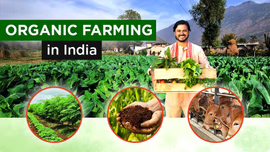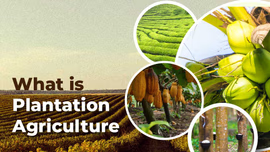A complete guide to Watermelon Cultivation in India

Watermelon is a popular summer fruit in India. It is loved for its sweet and refreshing taste. Growing watermelons is also highly profitable for farmers, especially in India, where some regions have the ideal climate for watermelon cultivation. This article covers some fundamental aspects of watermelon cultivation, such as land preparation, harvesting, storage, transportation, and much more.
Table of Contents
Introduction to Watermelon
Watermelon (Citrullus lanatus) has been grown all around the globe for thousands of years. It is a flowering plant species in the Cucurbitaceae family (which also contains other members of the gourd family, such as squash, cucumber, calabar, muskmelon, snake gourd, etc.). Watermelon first originated on the continent of Africa around 2000 years ago and arrived in India via trade. Today, India is one of the largest producers of watermelon, harvesting around 3.5 million metric tonnes from 1.22 lakh hectares of land in the year 2022-2023. Major watermelon-producing states in India include Uttar Pradesh, Andhra Pradesh, Tamil Nadu, Karnataka, and Odisha.
Watermelon grows fast and thrives in warm weather. It is a vine plant that spreads up to 3 meters long. Depending on the variety, the fruit takes 70-100 days to mature, with smaller types maturing in 70-75 days. The plant requires a good amount of water, especially during the flowering and fruit development stages.
Watermelon is also a highly nutritious fruit. It contains about 92% water, 7% carbohydrates, 0.2% protein and 0.3% minerals. It is also high in vitamins A, C, and B-complex. The fruit also contains antioxidant properties such as lycopene, which is good for your heart health.
Different Varieties of Watermelon Available in India
There are different varieties of Watermelon grown in different parts of India. Here is a list of some of the different varieties available in the country:
|
Name of Variety |
Characteristics |
Average Yield |
|
Sugar Baby |
Small, round fruits (3-5 kg), bluish-black outer skin, deep pink flesh, small seeds |
72 quintal/acre |
|
Improved Shipper |
Large fruits, dark green outer skin, moderately sweet (8-9 kg) |
70-80 quintal/acre |
|
Arka Muthu |
Early Maturing (75-80 days), round fruits with dark green stripes, deep red flesh, icebox type (2-3 kg) |
200 quintal/acre |
|
Arka Aishwarya |
High-yielding F1 hybrid, oblong fruits, red flesh, sweet taste, (10-12 kg) Maturing (90-100 days) |
300 quintal/acre |
|
Arka Akash |
High-yielding F1 hybrid, round to oval fruits, light green with dark green stripes, red flesh (6.5 kg) |
200-300 quintal/acre |
|
Arka Manik |
Crimson flesh, granular texture, aromatic, very sweet avg. weight 6 kg, resistant to mildew & anthracnose |
200 quintal/acre |
Steps of Watermelon Farming:
Soil and Climate
Watermelon is a summer crop and grows in the hot and dry regions of Rajasthan, Tamil Nadu, Karnataka, Andhra Pradesh, Odisha, and West Bengal. Watermelons can be cultivated on well-drained sandy to sandy loam soils and medium black soils, rich in organic matter. These plants grow well in slightly acidic soil conditions; therefore, the ideal soil pH should be kept between 6.0 and 7.5. Highly acidic soil can also be harmful for the plant. Watermelon cannot survive in cold weather unless grown in a greenhouse with proper protection. The best temperature for seed germination and plant growth is between 24-27°C.
Land Preparation and Sowing
To prepare the land, plough the field well until the soil becomes soft and fine. Watermelons typically get seeded directly on fields. If protection against freezing is required, it is sown in nurseries or greenhouses before it is planted onto the main field. Watermelon is usually sown between February and March in North India, and November and January in West and Northeast India. The seeds are typically placed 2-3 cm below the topsoil.
Here are three methods of sowing watermelons:
|
Method of Sowing |
Row Spacing |
Plant Spacing |
Characteristics |
|
Pit Sowing |
2-3 m |
60 cm |
4 seeds are to be planted in a pit. Fill the pits with FYM and manure One or two seedlings per pit after germination. |
|
Furrow Sowing |
2-3 m |
60-90 cm |
Seeds planted on both sides of the furrows 2-4 seeds per furrow 1 seedling per furrow after germination. |
|
Hill Sowing |
1-1.5 m |
30 cm |
Hills are built using soil and decomposing dung 2 seedlings per hill. |
The methods of sowing you choose depends on the climate and season.
Irrigation & Fertiliser Management
Watermelon is a fruit that grows in summer (humid) and warm climatic conditions. For this reason, the land must be irrigated thoroughly for the fruit to grow. Here are some steps on how to irrigate Watermelon crop properly –
- Water the beds two days before sowing and five days after sowing.
- Irrigate once a week as the plant grows.
- Prevent water stress, especially during pre-flowering, flowering, and fruiting stages, to ensure good fruit development.
- Apply water only to the root zone. Avoid water on the vines, leaves, flowers, and fruits to prevent diseases and damage. Keep moisture near the roots to help the plant develop a strong taproot.
- A total of 7-9 irrigations are needed for the entire crop cycle.
- For transplanted seedlings, irrigate immediately after transplanting, then every 10-14 days
- Drip irrigation is highly recommended as it improves fruit quality, reduces disease and weeds, and conserves water.
- Gradually decrease irrigation when the fruits are ripening and completely stop before harvesting.
Watermelon needs a healthy dose of fertiliser to grow, just like any other crop. You can determine which type of fertiliser to use and when to use it by reviewing the table below:
|
Nutrient |
Type of Fertilizer |
Quantity |
Application Stage |
|
Organic Fertilizers
|
FYM (Farmyard Manure) |
8 tons/acre |
To be mixed with soil during ploughing |
|
Neem Cake |
40 Kg |
To be mixed with soil during ploughing |
|
|
Humetsu Humic Acid |
Drenching: 4-5 ml/lit water Folier Spray: 2-2.5 ml/lit water |
Soil drenching: After irrigation Foliar Spray: 2-3 times during root formation, branching, and flowering to early fruit setting |
|
|
Nitrogen (N) |
Urea |
Basal: 43 kg Top Dressing: 43 kg |
Basal: Before or during planting Dressing: 30-35 days after sowing
|
|
Phosphorus (P) |
Single Super Phosphate (SSP) |
125 kg |
Basal application |
|
Potassium (K) |
Muriate of Potash (MOP) |
50 kg |
Basal application |
|
Calcium (Ca) & Boron (B) |
Multiplex Chamak Micronutrient |
3gm/lit water (Folier Spray) |
Start spraying at flower initiation with 2-3 sprays every 20-25 days |
|
Magnesium |
Multiplex Moti Mg |
0.5 gm/lit water (Foliar Spray) |
1st spray: 1 month after sowing 2nd spray: 15 days after first spray |
|
Micronutrient + Seaweed extract |
Tapas Pushti All Plant Nutrient Mix |
0.25 gm/lit water (Foliar Spray) |
1st spray: After 2-leaf stage 2nd spray: 15-20 days after first spray |
Disease and Plant Protection
Here are some of the diseases that can occur in a Watermelon plant and ways you can prevent them
|
Disease |
Cause (How it happens) |
Symptoms (Signs to Watch out for) |
Prevention |
|
Fusarium Wilt |
Soil-borne fungus (Fusarium oxysporum) spreads through contaminated soil and seeds. |
Leaves turn yellow, wilt, and dry up; plant growth stunts |
Practice crop rotation and avoid water logging. |
|
Powdery Mildew |
Fungal infection (Podosphaera xanthii), spreads in dry, warm conditions. |
White powdery patches on leaves, curling, and stunted growth. |
Ensure good air circulation, avoid overhead watering, and use resistant varieties. |
|
Downey Mildew |
Fungal infection (Pseudoperonospora cubensis), spreads in humid conditions. |
Yellow spots on leaves that turn brown; leaves curl and die. |
Grow in well-drained soil, avoid excess moisture, and use fungicides when needed. |
|
Anthracnose |
Fungus (Colletotrichum lagenarium), spreads through rain, infected seeds, and high humidity. |
Dark, sunken spots on leaves, stems, and fruits, lead to rotting. |
Rotate crops and remove infected leaves. |
Pollination
Pollination is also an important step in the watermelon cultivation process. Because male and female plants grow on the same plant but separately, watermelon plants cannot mature into fruits on their own. There are two methods for pollinating a Watermelon plant. The first happens naturally through honeybees. Bees transfer pollen from flower to flower as they gather nectar. For this reason, putting up an artificial beehive in the watermelon field is a smart idea. To increase pollination frequency, you can place 1 or 2 beehives per acre.
During natural pollination, spraying chemicals in the morning during the flowering stage is not recommended.
The second approach involves manual pollination. Manual pollination should be done in the early morning. Pluck the male flowers and remove the petals around them. The stamen of the male flower (which holds pollen) is to be brushed against the stigma of the female flower (which is in the centre). This helps pollen cling to the female flower.
Harvesting of Watermelon
Watermelons are ready to harvest when the tendrils around the stem begin drying and the white section of the fruit touching the ground turns yellow.
You can also tell when the Watermelons make a thudding sound when thumped (whereas immature fruits make a thick sound). Fruits mature only when they are linked to the vine. Therefore, immature fruits must be left alone if not yet ready. To harvest mature fruits, cut the stem about an inch away from the fruit with a knife. After harvesting, the fruits are evaluated according to their size. Store them at 15⁰C for up to two weeks.
Storage and transportation
Watermelon stays fresh for around 15 days at 15°C. Lower temperatures can lead to chilling damage. It does not withstand prolonged travelling. To reduce damage and bruising while transporting fruits in trucks, place them on dried grass. Watermelons should not be stored or transported with apples, tomatoes, muskmelon, or bananas because the ethylene released by these fruits speeds up softening and the development of off flavor in watermelons. Long periods of storage have a considerable risk of causing freshness and colour deterioration.


Related Blogs












